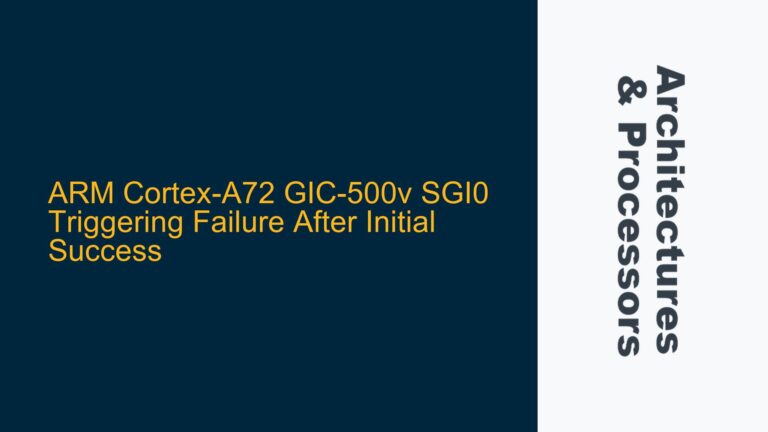Cortex-R52 Based SoC Requirements for Automotive Use Cases
The Cortex-R52 processor, designed by ARM, is a highly capable real-time processor that is particularly well-suited for safety-critical applications, such as those found in the automotive industry. When selecting a Cortex-R52 based System on Chip (SoC) for automotive use, several key requirements must be considered to ensure that the chosen solution meets the stringent demands of this sector. These requirements include not only the performance characteristics of the processor but also its certification for automotive use, its physical footprint, and its core configuration.
The Cortex-R52 is often chosen for automotive applications due to its ability to support lock-step configurations, which are essential for achieving the high levels of reliability and fault tolerance required in safety-critical systems. In a lock-step configuration, two cores execute the same instructions simultaneously, and their outputs are compared to detect any discrepancies that could indicate a hardware fault. This configuration is particularly important in automotive applications, where a single fault could have catastrophic consequences.
In addition to the lock-step configuration, the Cortex-R52 also supports a range of other features that are beneficial for automotive applications. These include support for virtualization, which allows multiple operating systems to run on the same hardware, and advanced error correction mechanisms, which help to ensure data integrity even in the presence of hardware faults. The Cortex-R52 also includes a Memory Protection Unit (MPU), which can be used to enforce strict memory access controls, further enhancing the security and reliability of the system.
When selecting a Cortex-R52 based SoC for automotive use, it is important to consider not only the performance characteristics of the processor but also its certification for automotive use. Automotive applications are subject to a range of stringent safety and reliability standards, such as ISO 26262, which defines the functional safety requirements for road vehicles. To ensure compliance with these standards, it is essential to select an SoC that has been fully certified for automotive use.
The physical footprint of the SoC is another important consideration, particularly in automotive applications where space is often at a premium. The Cortex-R52 is designed to be highly efficient, both in terms of power consumption and physical size, making it well-suited for use in compact automotive systems. However, the overall footprint of the SoC will also depend on the specific implementation, including the number of cores, the size of the on-chip memory, and the presence of additional peripherals.
Finally, the core configuration of the SoC must be carefully considered. For automotive applications, a dual-core lock-step configuration is often preferred, as it provides the necessary level of fault tolerance without the complexity and power consumption of a larger multi-core system. The Cortex-R52 supports dual-core lock-step configurations, making it an ideal choice for these applications.
Challenges in Identifying Small Footprint Cortex-R52 SoCs
Identifying a Cortex-R52 based SoC that meets the specific requirements of automotive applications can be challenging, particularly when the goal is to find the smallest possible footprint. One of the primary challenges is the limited availability of Cortex-R52 based SoCs that are fully certified for automotive use. While the Cortex-R52 itself is a popular choice for automotive applications, not all SoC vendors offer products that are specifically designed and certified for this market.
Another challenge is the trade-off between performance and footprint. While the Cortex-R52 is designed to be highly efficient, the overall footprint of the SoC will depend on a range of factors, including the number of cores, the size of the on-chip memory, and the presence of additional peripherals. In some cases, it may be necessary to make compromises in terms of performance or functionality in order to achieve the desired footprint.
The core configuration of the SoC is another important consideration. While a dual-core lock-step configuration is often preferred for automotive applications, not all Cortex-R52 based SoCs offer this configuration. Some SoCs may only be available in larger multi-core configurations, which may not be suitable for all automotive applications.
In addition to these challenges, there is also the issue of availability. The Cortex-R52 is a relatively new processor, and as such, there may be limited availability of SoCs based on this architecture. This can make it difficult to find a suitable SoC that meets all of the requirements for a specific automotive application.
Finally, there is the challenge of ensuring that the selected SoC is fully certified for automotive use. This requires not only that the SoC itself is certified but also that the entire system, including any additional peripherals and software, meets the necessary safety and reliability standards. This can be a complex and time-consuming process, particularly for smaller companies that may not have the resources to conduct extensive testing and certification.
Strategies for Selecting and Optimizing Cortex-R52 SoCs for Automotive Applications
When selecting and optimizing a Cortex-R52 based SoC for automotive applications, there are several strategies that can be employed to ensure that the chosen solution meets the specific requirements of the application. These strategies include careful consideration of the SoC’s certification, footprint, core configuration, and performance characteristics, as well as the use of advanced optimization techniques to maximize the efficiency and reliability of the system.
One of the first steps in selecting a Cortex-R52 based SoC is to ensure that the chosen solution is fully certified for automotive use. This requires not only that the SoC itself is certified but also that the entire system, including any additional peripherals and software, meets the necessary safety and reliability standards. This can be a complex and time-consuming process, but it is essential for ensuring that the system is capable of meeting the stringent demands of the automotive industry.
Once a suitable SoC has been identified, the next step is to optimize the system for the specific requirements of the application. This may involve a range of techniques, including the use of advanced power management features to minimize power consumption, the implementation of strict memory access controls to enhance security and reliability, and the use of virtualization to allow multiple operating systems to run on the same hardware.
In addition to these techniques, it is also important to consider the core configuration of the SoC. For automotive applications, a dual-core lock-step configuration is often preferred, as it provides the necessary level of fault tolerance without the complexity and power consumption of a larger multi-core system. The Cortex-R52 supports dual-core lock-step configurations, making it an ideal choice for these applications.
Another important consideration is the physical footprint of the SoC. In automotive applications, space is often at a premium, so it is essential to select an SoC that is as compact as possible. This may require making compromises in terms of performance or functionality, but it is often necessary in order to achieve the desired footprint.
Finally, it is important to consider the performance characteristics of the SoC. While the Cortex-R52 is designed to be highly efficient, the overall performance of the system will depend on a range of factors, including the number of cores, the size of the on-chip memory, and the presence of additional peripherals. It is important to carefully evaluate these factors to ensure that the selected SoC is capable of meeting the performance requirements of the application.
In conclusion, selecting and optimizing a Cortex-R52 based SoC for automotive applications requires careful consideration of a range of factors, including certification, footprint, core configuration, and performance characteristics. By employing advanced optimization techniques and carefully evaluating the available options, it is possible to identify a solution that meets the specific requirements of the application while also ensuring the highest levels of safety, reliability, and efficiency.






